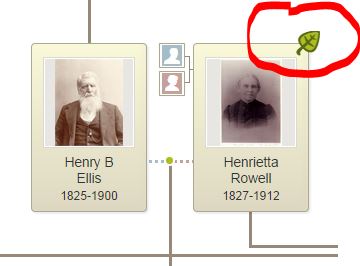by Lisa Cooke | Jul 12, 2014 | 01 What's New, History
 Just when you thought a claw-foot tub was the epitome of living in the past….
Just when you thought a claw-foot tub was the epitome of living in the past….
A historical consultant in Amsterdam is living in the past. To be more precise, she’s chosen to live like it’s 1938. Her apartment (except for the computer and the refrigerator) is entirely outfitted as if it’s 1938. She doesn’t have a television, she vacuums with a 1920s machine and she washes her clothes by hand.
She’s profiled here on Yahoo! Homes, where you can check out a slide show of her apartment.
What do you think about living in the past? If you could surround yourself with the trappings of an earlier decade, what would it be? What modern conveniences could you not live without?
by Diahan Southard | Sep 16, 2014 | 01 What's New, Ancestry, Trees
If you’re an Ancestry.com user, you’ve seen those “shaky leaves.” They are automated hints generated when Ancestry.com thinks a historical record or tree matches an individual on yours.
Are you getting the most out of your Ancestry.com shaky leaf hints? Check out this video on YouTube–then keep reading!
In a nutshell: look at all the hints. Then keep searching.
According to the Ancestry Insider blogger, hints are only provided for the top 10% of Ancestry records.
I asked our Genealogy Gems source at Ancestry.com about this. He did clarify that this means the most popular 10% of collections, which accounts for “a majority of the records.” But he also comments, “Hints are not meant to be an exhaustive method to flesh out all of the records for your ancestors. People should always search as well as use hints.”
After checking all the hints, I routinely find a LOT more by then searching records from an individual’s profile.
Search from the profile rather than the main search screen so some of the other data you’ve already found (like dates and relationships and locations) will be included automatically in the search parameters. I think searching from the individual profile also makes it faster to attach records to your person once you’ve found them.
Click here to hear how one woman used Ancestry.com hints to discover a tree for the biological mother who abandoned her when she was five. You’ll also learn her inspiring message about how moving past her mother on her family tree has helped her move on with her life.
by Lisa Cooke | Dec 4, 2013 | 01 What's New, Digital Archives
 I’ve blogged before about the relatively new Digital Public Library of America (here’s a post introducing the DPLA and here’s one on historical maps you’ll find there). Now the Library of Congress has posted a 31-minute webcast that features the DPLA content director, Emily Gore. She not only demonstrates some great examples of what you can find in the public portal of the DPLA, but also discusses the potential for gathering even more materials (she gives an example using local sources.) It’s a great introduction to the site, and Gore answers some questions from the audience that seem to be on a lot of people’s minds.
I’ve blogged before about the relatively new Digital Public Library of America (here’s a post introducing the DPLA and here’s one on historical maps you’ll find there). Now the Library of Congress has posted a 31-minute webcast that features the DPLA content director, Emily Gore. She not only demonstrates some great examples of what you can find in the public portal of the DPLA, but also discusses the potential for gathering even more materials (she gives an example using local sources.) It’s a great introduction to the site, and Gore answers some questions from the audience that seem to be on a lot of people’s minds.
Looking for a more basic intro to the DPLA? Check out this introductory video, too.
 Just when you thought a claw-foot tub was the epitome of living in the past….
Just when you thought a claw-foot tub was the epitome of living in the past….

